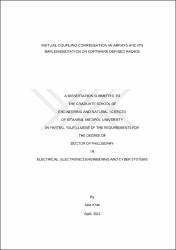Mutual coupling compensation in arrays and its implementation on software defined radios
Künye
Khan, S. (2021). Mutual coupling compensation in arrays and its implementation on software defined radios. (Unpublished doctoral’s thesis). İstanbul Medipol Üniversitesi Fen Bilimleri Enstitüsü, İstanbul.Özet
Mutual coupling in antenna arrays is a classical problem that has been researched for sev eral decades. This thesis presents two different algorithms along with their experimental verification by developing two different test beds for mutual coupling compensation in receiving antenna arrays using SDRs. The antenna arrays can be directional or omni directional and arranged in ULA, UCA or extended to arbitrary geometry. The effect of DoA with spacing was studied for ULA with spacing varied from 0.24... to 0.6... with real time coupling compensation. The results showed that DoA can be estimated with full accuracy in an indoor environment without the use of an anechoic chamber after compen sation using a decoupling matrix which can be calculated by online or offline methods. In order to study the effect of coupling in realtime on data rates, an IEEE 802.11a standard was implemented for SIMO endtoend transceiver using Zynq Radio and Xilinx FPGA. The transmitter sends an HD picture using the 802.11a standard and the receiver decodes the data in the presence of mutual coupling and after compensation in realtime. The performance metrics like SNR, PER, EVM , channel capacity are analyzed along with vi sualization of effects of mutual coupling and its compensation in both time and frequency domain. The results show that at low RSSI the received signal can have a 10 dB SNR gain after compensation and an increase of 4 bps/Hz in channel capacity. A mathemati cal model using a closedform equation for the decoupling matrix has been developed for ULA and UCA geometries and can be easily extended to arbitrary geometries which can be precalculated irrespective of the antenna type in the array. The computational com plexity is only a single matrix multiplication. Furthermore, the algorithm was also tested in the transmitting case where favourable results have been achieved. Anten dizilerinde karşılıklı kuplaj, on yıllardır araştırılan klasik bir sorundur. Bu tez, SDR'leri kullanarak anten dizilerini almak için iki farklı test yatağı geliştirerek deneysel doğrulamalarıyla birlikte iki farklı algoritma sunar. Anten dizileri izotropik veya çok yönlü olabilir ve ULA, UCA'da düzenlenebilir veya herhangi bir geometriye genişletilebilir. DoA'nın etkisi, 0.24... ile 0.6... arasında değişen aralık değerleriyle ve gerçek zamanlı karşılıklı kuplaj telafisi ile ULA için incelendi. Sonuçlar, DoA'nın kuplaj kaldırıldıktan sonra yankısız bir oda kullanılmadan, kapalı bir ortamda çevrimiçi veya çevrimdışı yöntemlerle hesaplanabilen bir dekuplaj matrisi kullanılarak tam doğrulukla tahmin edilebileceğini gösterdi. Kuplajın veri hızlarındaki etkisini gerçek zamanlı olarak incelemek için, Zynq Radio ve Xilinx FPGA kullanılarak SIMO alıcıverici için bir IEEE 802.11a standardı uygulandı. Verici, 802.11a standardını kullanarak bir HD resim gönderir ve alıcı karşılıklı kuplaj varlığında verilerin kodunu zamandan kompanzasyonundan sonra çözer. SNR, PER, EVM, kanal kapasitesi gibi performans ölçümleri, karşılıklı kuplajın etkilerinin hem zaman hem de frekans alanındaki kompanzasyonu ile birlikte görselleştir ilmesiyle analiz edilir. Sonuçlar, düşük RSSI'da alınan sinyalin kompanzasyon sonrasında 10 dB SNR kazancına ve kanal kapasitesinde 4 bps / Hz artışa sahip olabileceğini göster mektedir. Dekuplaj matrisi için kapalı form denklemi kullanan matematiksel bir model, ULA ve UCA geometrileri için geliştirilmiştir ve dizideki anten tipine bakılmaksızın önce den hesaplanabilen keyfi geometrilere kolaylıkla genişletilebilir. Hesaplama karmaşıklığı yalnızca tek bir matris çarpımıdır. Ayrıca, algoritma olumlu sonuçların elde edildiği iletim durumunda da test edilmiştir.
Koleksiyonlar
- Tez Koleksiyonu [75]


















